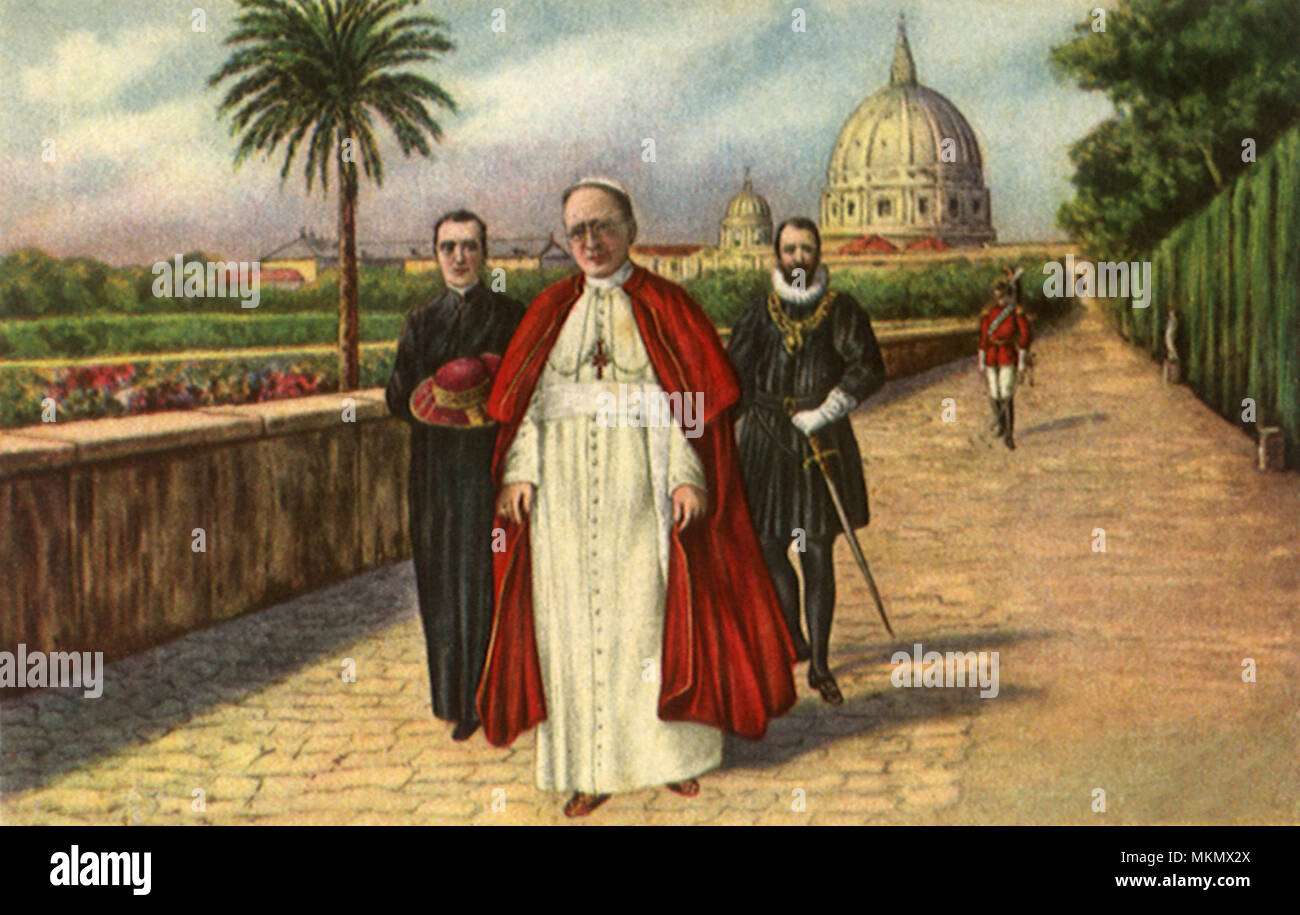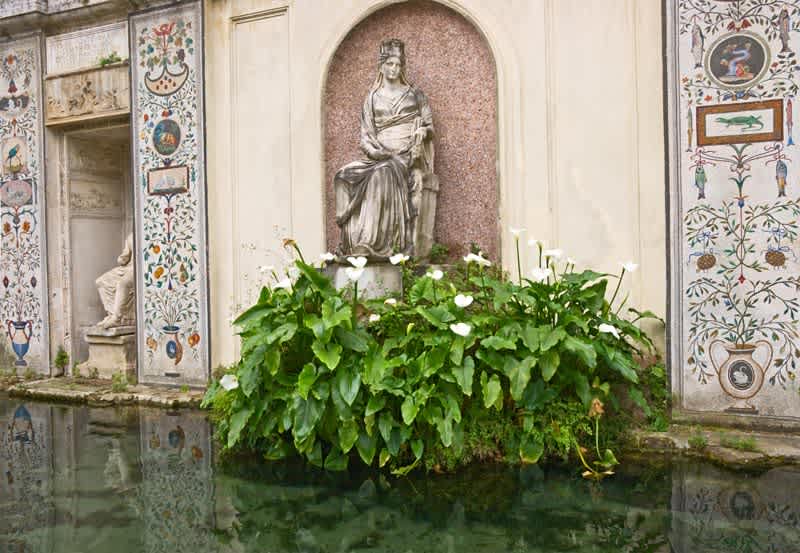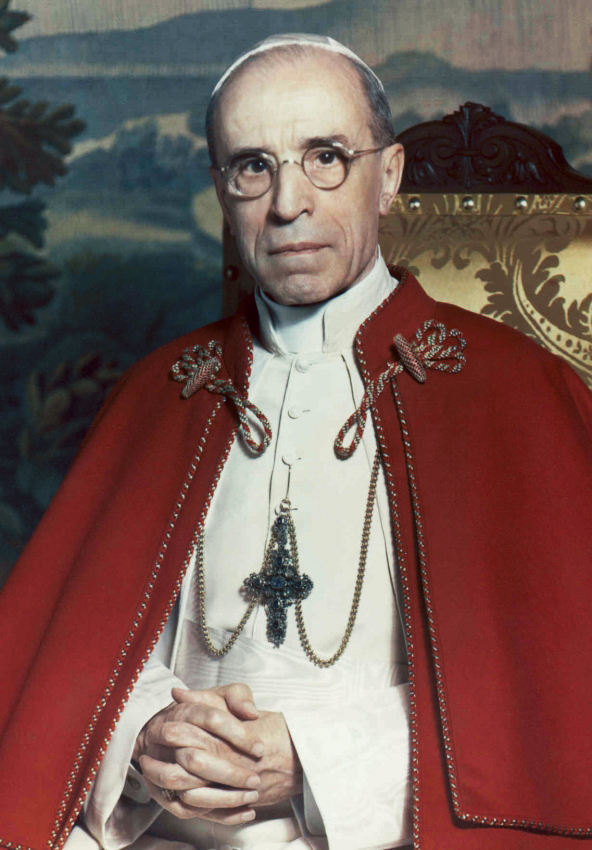In the annals of modern Catholic history, few figures spark as much passionate debate as Pope Pius XII, born Eugenio Maria Giuseppe Giovanni Pacelli 2. Known by some as the “Silent Savior” and by others as the “Pope of Silence,” his papacy during World War II and the Holocaust presents one of the most complex moral narratives of the 20th century 3. For Catholics seeking to deepen their faith, his story offers profound lessons about leadership under impossible circumstances, the power of mystical experiences, and the delicate balance between prudence and courage in the face of evil 4.
This remarkable pontiff’s journey from a fragile Roman diplomat to the spiritual leader of 400 million Catholics during humanity’s darkest hour reveals timeless truths about faith, sacrifice, and the mysterious ways God works through imperfect instruments 5.

A formal portrait of Pope Pius XII wearing an ornate stolewikimedia
Historical Context: A Pope Born for Crisis
Eugenio Pacelli entered the world on March 2, 1876, in Rome, into a family deeply devoted to Vatican service 2. His great-grandfather had served as minister of finance under Pope Gregory XVI, and his father was dean of the Vatican lawyers 3. This papal nobility background would shape his entire worldview, but it was his fragile health as a child that proved most formative 10.
Unlike other seminarians, young Pacelli studied for the priesthood at home due to his delicate constitution 10. This isolated education fostered the introspective and meticulous personality that would later define his papacy 2. Ordained in 1899, he quickly caught the attention of Vatican officials for his exceptional intelligence and diplomatic skills 3.
His transformation from shy scholar to seasoned strategist occurred during his twelve years in Germany (1917-1929), first as apostolic nuncio to Bavaria, then to the entire nation 5. During this crucial period, Pacelli witnessed firsthand the collapse of empires, communist revolutions, and the early rise of the Nazi Party 2. These traumatic experiences convinced him that Soviet communism posed the greatest existential threat to the Church—a conviction that would profoundly influence his wartime decisions 3.
When Cardinal Pacelli was elected pope on March 2, 1939—his 63rd birthday—he chose the name Pius XII and assumed leadership just six months before Hitler invaded Poland 4. The timing could not have been more prophetic or tragic 1.
Spiritual Journey: From Diplomat to Mystic
Pius XII’s spiritual development paralleled his diplomatic career in remarkable ways 9. Initially known for his cautious, cerebral approach to problems, his faith deepened through personal mystical experiences that few understood at the time 27. His years in Germany had made him fluent in European politics, but it was his direct encounters with the divine that guided his most controversial decisions 1.
The pope’s spirituality was profoundly Marian, rooted in childhood devotion but intensified by wartime suffering 12. He saw in the Virgin Mary not merely the Mother of God, but the Queen of Peace—the only force capable of interceding for humanity in its darkest moments 11. This devotion would culminate in extraordinary mystical visions that connected his papacy to the mysteries of Fatima 27.
His prayer life, revealed in personal diaries, shows a man constantly seeking divine guidance for impossible decisions 22. Unlike the diplomatic calculations that marked his professional life, his spiritual journey was marked by supernatural experiences that convinced him he was an instrument of divine providence 27.
The Holocaust Controversy: Silence and Secret Action
The most debated aspect of Pius XII’s papacy remains his response to the Holocaust 5. Publicly, he maintained a policy of “impartiality,” avoiding explicit condemnation of Nazi atrocities even as 1,259 Jews were deported from Rome under his very window on October 16, 1943 6. Critics argue this silence represented a moral failure that prioritized Church preservation over defending the innocent 5.
However, newly opened Vatican archives reveal a dramatically different story 17. Behind the scenes, Pius XII orchestrated one of history’s most extensive rescue operations 15. He instructed papal nuncios across Europe to provide false baptismal certificates for Jews, transforming thousands into “Catholics” overnight 25. In Rome alone, convents and monasteries sheltered over 4,700 Jews during the Nazi occupation, while the Vatican itself hid 277 refugees at Castel Gandolfo 15.
The pope’s “golden silence” strategy had brutal but effective logic 25. Every time Catholic bishops publicly protested Nazi atrocities, reprisals intensified 6. In the Netherlands, when bishops publicly denounced Jewish deportations in July 1942, the Nazis immediately deported all converted Jews, including future saint Edith Stein 15. This lesson was clear: public protests often cost more lives than they saved 25.
Recent discoveries include a 1942 letter showing Pius XII had detailed information about Nazi extermination camps, including reports that 6,000 Jews and Poles were being gassed daily 26. Yet he maintained his diplomatic approach, believing secret action would prove more effective than public denunciation 25.
Historians now estimate that actions coordinated by Pius XII saved between 800,000 and 900,000 Jewish lives 4. In Rome, where he had direct control, 80% of the Jewish population survived—one of the highest survival rates in occupied Europe 15.

Pope Pius XII Walking in the Vatican Gardensalamy
Theological Legacy: The Mystical Body and Modern Doctrine
Beyond wartime controversies, Pius XII’s theological contributions fundamentally shaped modern Catholicism 9. His 41 encyclicals and nearly 1,000 speeches addressed everything from biblical scholarship to liturgical reform 2. Most significantly, his encyclical Mystici Corporis Christi redefined understanding of the Church as the “Mystical Body of Christ” 8.
This theology emphasized that the Church operates as a living organism, with Christ as the head and believers as members 16. Far from abstract doctrine, this teaching provided a subtle but powerful critique of totalitarian ideologies that demanded absolute loyalty to earthly powers 9. By insisting that ultimate allegiance belonged to Christ alone, Pius XII offered Catholics a theological framework for resistance 8.
His encyclical Divino Afflante Spiritu revolutionized Catholic biblical scholarship by encouraging investigation of original Hebrew and Greek texts 2. This opened doors for historical-critical biblical studies that would flourish at Vatican II 9.
Perhaps most dramatically, on November 1, 1950, Pius XII invoked papal infallibility to proclaim the dogma of the Assumption of Mary 11. This declaration that Mary was assumed body and soul into heaven represented only the second time in Church history that a pope had made an infallible ex cathedra statement 13.

The Assumption of the Virgin Mary depicted in a classical Baroque stylenga
Mystical Visions: The Miracle of the Sun
One of the most extraordinary aspects of Pius XII’s papacy was his reported mystical experiences, particularly his witness to the “Miracle of the Sun” 27. On October 30, 1950, while walking in the Vatican gardens and praying about proclaiming the Assumption dogma, the pope witnessed something supernatural 19.
In a handwritten note, he wrote: “I have seen the ‘miracle of the sun,’ this is the pure truth” 27. He described seeing the sun as “a pale, opaque sphere, entirely surrounded by a luminous circle,” moving and pulsating in ways that defied natural law 27. This phenomenon occurred on four different occasions between October and November 1950 1.

A Quiet corner in the Vatican Gardens featuring classical statues and mosaicsthrougheternity
The timing was deeply significant—these visions occurred precisely as Pius XII contemplated the Assumption proclamation 27. He interpreted them as divine confirmation to proceed, noting the connection to the Fatima apparitions of 1917 19. Remarkably, he had been consecrated archbishop on May 13, 1917—the same day as the first Fatima apparition 27.
For Pius XII, these weren’t isolated mystical experiences but part of a divine plan connecting his controversial papacy to heaven’s deepest mysteries 1. He also reported direct visions of Christ and Mary during the war’s most critical moments, experiences that supposedly guided his most difficult decisions 1.
The Path to Sainthood: Miracles and Controversy
The canonization process for Pius XII began shortly after his death in 1958 but has proven extraordinarily controversial 7. In December 2009, Pope Benedict XVI declared him “Venerable,” recognizing his “heroic virtues” and taking the first official step toward possible sainthood 24.
The case centers on a remarkable miracle involving Maria Esposito, a 31-year-old Italian teacher diagnosed with aggressive Burkitt’s lymphoma while pregnant in 2005 20. Doctors gave her little hope—this rare cancer has a mortality rate over 90% 21. Initially, her husband prayed to the recently deceased John Paul II, but in a vivid dream, that pope reportedly directed him to “pray to this other priest,” showing him an image of a thin, tall cleric 22.
Days later, the husband recognized Pope Pius XII in a magazine photograph as the priest from his dream 23. The family immediately began praying for Pius XII’s intercession 20. After just one cycle of chemotherapy—normally insufficient for such aggressive cancer—Maria was completely cured 21. Her doctors found no medical explanation for the recovery 20.
The Congregation for the Causes of Saints investigated extensively, with independent medical experts confirming the healing defied scientific explanation 21. However, Pius XII’s controversial wartime record continues to complicate his path to sainthood 7.
Legacy: Lessons for Modern Catholics
Pius XII’s complex legacy offers profound spiritual lessons for contemporary Catholics facing their own moral challenges 10. His story teaches us that sanctity doesn’t require perfection, but rather faithful service despite human limitations 2.
Key spiritual lessons include:
- Prudent Action Over Public Posturing: Sometimes the greatest acts of faith occur in secret 15. Like Pius XII’s hidden rescue operations, our quiet prayers and small acts of kindness can have profound impacts invisible to the world 25.
- Trust in Divine Guidance: His mystical experiences remind us to seek God’s voice in difficult decisions 27. Even when the path seems unclear, we can trust that divine providence works through our faithful efforts 19.
- Navigating Moral Complexity: In our polarized world, Pius XII’s story teaches us to embrace nuance rather than seeking simplistic answers to complex problems 5. Good and imperfect choices often coexist in real-world situations 6.
- Perseverance Under Criticism: Despite decades of harsh judgment, Pius XII remained committed to his mission 7. We too can endure misunderstanding by anchoring ourselves in faith rather than public approval 24.
- Marian Devotion in Dark Times: His profound trust in Mary’s intercession sustained him through impossible circumstances 11. Modern Catholics can find similar strength through genuine Marian devotion 12.
Conclusion: A Complex Saint for Complex Times
Pope Pius XII’s story defies easy categorization—he was simultaneously the “Silent Savior” and the “Pope of Silence,” a mystical visionary and pragmatic diplomat, a secret hero and controversial figure 2. For Catholics seeking to deepen their faith, his legacy offers not simple answers but profound questions about how we live our beliefs when the stakes are highest 5.
His life reminds us that sainthood isn’t about moral perfection but about faithful service despite human limitations 10. The same hands that may have hesitated to speak publicly against evil also secretly coordinated the rescue of hundreds of thousands of innocent lives 15. The same mind that calculated diplomatic risks also experienced extraordinary mystical visions that shaped Catholic doctrine 27.
In our own complex times, Pius XII’s story challenges us to embrace the mystery of how God works through imperfect instruments 9. Perhaps the question isn’t whether he was a perfect saint, but what his imperfect sainthood teaches us about faithful living in an ambiguous world 7.
As we await the final verdict on his canonization, we can learn from both his courage and his caution, his mystical experiences and his diplomatic prudence 24. In the end, Pope Pius XII’s legacy may be that he shows us what it means to seek God’s will in the darkness, trusting that divine light can shine through even the most flawed human vessels 19.
Featured Image
Suggested Featured Image: A formal portrait of Pope Pius XII
Link: Available through Wikimedia Commons at https://commons.wikimedia.org/wiki/File:Pius_XII,_1953.jpg
Description: A dignified portrait of Pope Pius XII wearing his papal vestments, capturing the contemplative nature of this complex pontiff who led the Church through its most challenging era.
Additional Images
Additional Image 1: Vatican Gardens Scene
Link: Available through Wikimedia Commons
Caption: The peaceful Vatican Gardens where Pope Pius XII experienced mystical visions, including witnessing the “Miracle of the Sun” in 1950.
Additional Image 2: Assumption of Mary Artwork
Link: Available through various museum collections and Wikimedia Commons
Caption: Classical artistic representation of the Assumption of Mary, the dogma proclaimed by Pope Pius XII in 1950 following his mystical experiences.
SEO and WordPress Settings
- Slug: pope-pius-xii-silent-savior-faith-controversy
- SEO Title: Pope Pius XII: The Silent Savior – Faith and Controversy in Dark Times
- Meta Description: Discover the complex legacy of Pope Pius XII, the controversial wartime pope who saved thousands while facing criticism. Explore his mystical visions, theological contributions, and path to sainthood.
- Focus Keyword: Pope Pius XII
- Tags: Pope Pius XII, Catholic saints, World War II, Holocaust history, papal history, mystical experiences, Assumption dogma, Catholic theology, Vatican history, canonization process, Marian devotion, Catholic faith
- Categories: Catholic Saints, Church History, Papal Biography, Faith and Spirituality
References
- Pope Pius XII – Wikipedia
- Pius XII | Biography, World War II, Cause of Death, Sainthood, & Facts – Britannica
- Legacy of Pope Pius XII lives on 66 years after his death – Vatican News
- Pope Pius XII & the Holocaust – Jewish Virtual Library
- Vatican opens archives of Holocaust-era Pope Pius XII – BBC
- Did Pius XII Remain Silent? – EWTN
- Miracle claimed for WWII-era pope – NBC News
Connect with Us!
Explore more Catholic content and support our mission:

